To achieve competitive advantage and sustainable growth, organizations must optimize every step of their sales process—from the first customer inquiry to the final payment collection. The SAP SD (Sales and Distribution) Order to Cash process empowers project leaders, IT directors, and business decision-makers to drive operational excellence and unlock measurable financial performance.
By leveraging SAP’s deeply integrated approach, you can streamline sales cycles, minimize errors, and unify data to deliver faster, more accurate business outcomes. Mastering this process is critical for reducing revenue leakage, maximizing cash flow, and building a resilient sales engine that supports both immediate goals and long-term strategy.
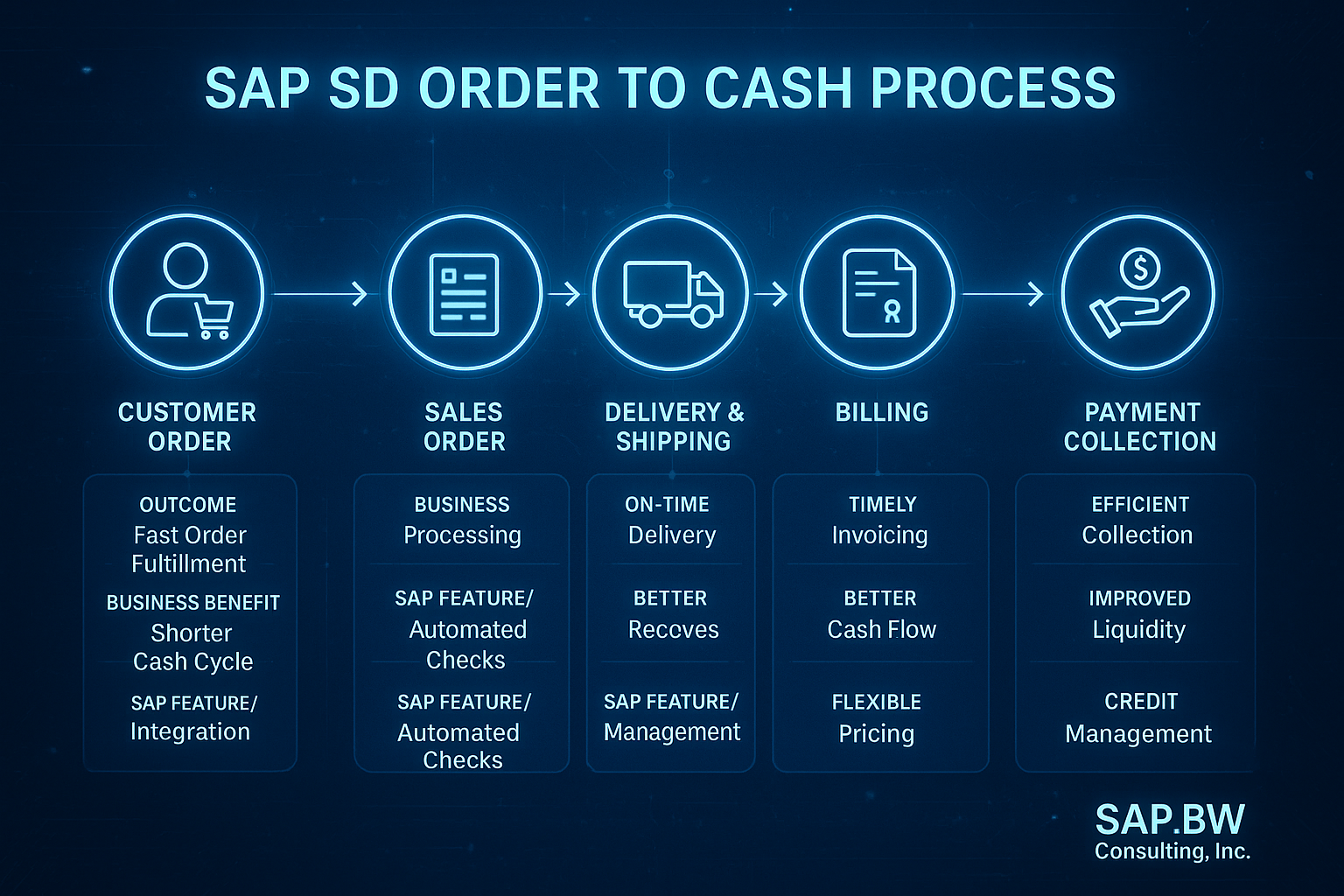
The strength of the SAP OTC process lies in its deep integration with other SAP modules, such as Materials Management (MM) and Finance (FI). This integration allows for a seamless flow of information across departments, which helps reduce data entry errors and accelerate the entire sales cycle. It eliminates information silos and provides a single source of truth for all customer orders.
Need SAP Sales & Distribution Consulting.
Key Components of SAP SD Order to Cash
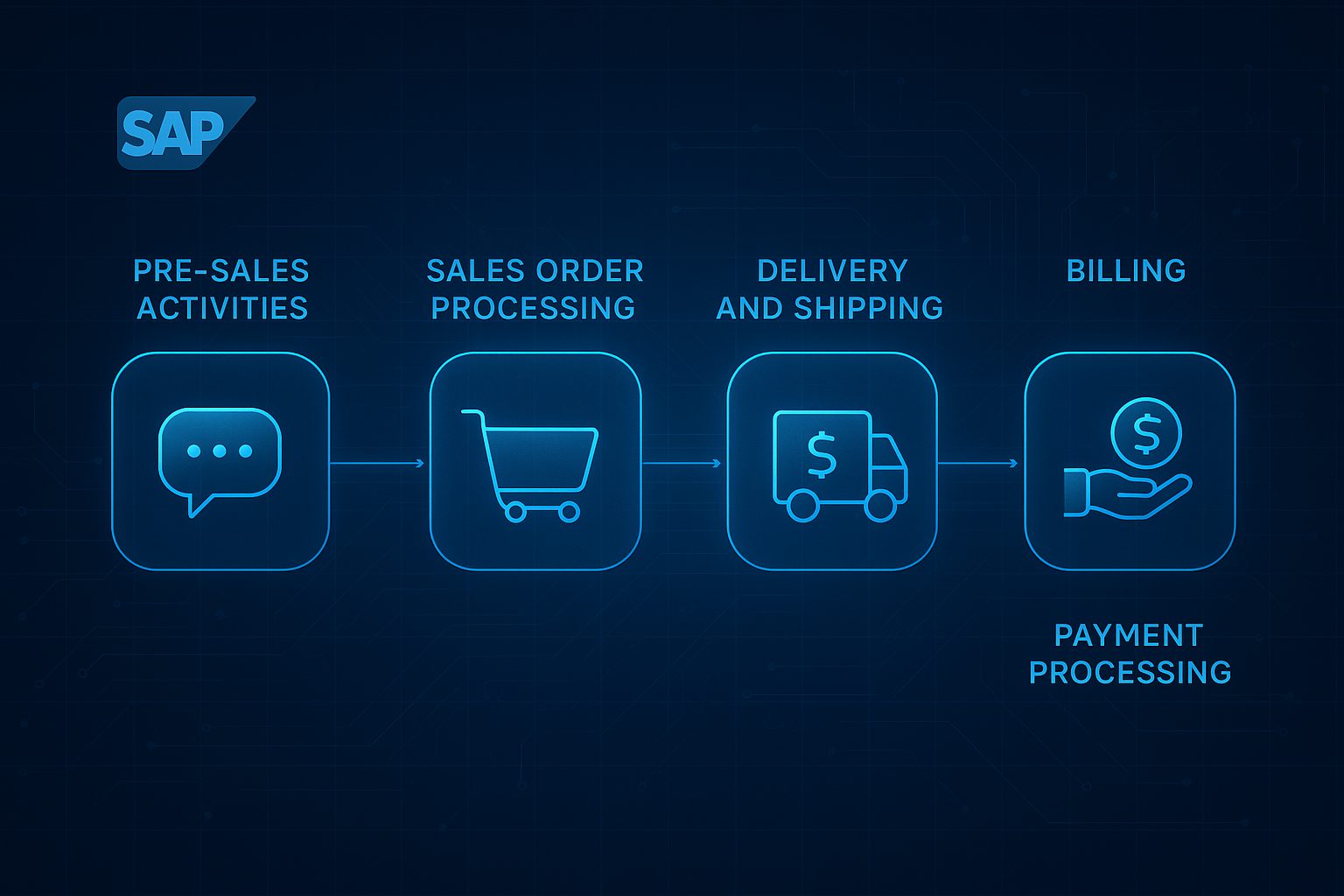
The complete order-to-cash process consists of several distinct stages. Each stage has specific functions and contributes to the overall efficiency of managing customer orders. Let's explore the key process steps in detail.
1. Pre-Sales Activities
The entire process starts before a sale is even made. Pre-sales activities involve handling customer inquiries and creating quotations. The sales team creates a quotation document that outlines product details, pricing, and potential delivery dates for the customer.
These activities are logged in the SAP system, providing valuable data for sales forecasting and customer relationship management. This initial sales document sets the stage for a smooth transaction. This phase is crucial for converting leads into actual sales orders.
2. Sales Order Processing
When a customer agrees to the quotation, the next step is sales order creation. The sales team creates a formal sales order in the system, often using transaction code VA01. This sales order is a legal document confirming the intent to purchase and includes all relevant details like materials, quantities, pricing, and shipping details.
During sales order processing, the system performs several automated checks. An availability check confirms if the required products are in stock or can be produced in time. A credit check is also performed against the customer's established credit limit to manage financial risk for the company.
This order management function is at the core of the SD module. Accurate master data, including customer information and product pricing, is vital for the sales order to be processed correctly. This step ensures the company can fulfill the customer order as promised.
3. Delivery and Shipping
Once the sales order is confirmed and stock availability is verified, delivery processing begins. The system creates a delivery document, which authorizes the warehouse management team to pick and pack the goods. This document is the basis for all shipping activities.
The most critical part of this stage is the post goods issue step. When the goods leave the warehouse, a goods issue is posted in the system. This action reduces inventory levels, updates the general ledger with the cost of goods sold, and signals that the items are on their way to the customer.
The goods issue step is irreversible and updates delivery status in the sales order document flow. It confirms that ownership of the goods has transferred. This part of the cash process is essential for accurate inventory and financial reporting.
4. Billing
Following the post goods issue, the billing process can start. The system generates a billing document, commonly a customer invoice, based on the information from the sales order and delivery document. This document details the amount the customer owes and includes any applicable taxes.
The creation of billing documents is a key financial step in the OTC process. It records the revenue and creates a corresponding entry in accounts receivable, officially logging the customer's debt. In cases of returns or pricing discrepancies, a credit memo may be created to adjust the customer's account.
5. Payment Processing
The final stage of the SAP OTC process is receiving and processing the customer's payment. The customer receives the invoice and submits payment according to the agreed-upon terms. This can be handled through various channels, including bank transfers or an online payment portal.
Once payment is received, the accounts receivable department posts the incoming funds against the open customer invoice. This clears the customer's account and completes the order-to-cash cycle. Timely payment processing is vital for maintaining healthy cash flow and a strong balance sheet.
To help you understand the flow, here is a table of common transaction codes used in the SAP SD Order to Cash process:
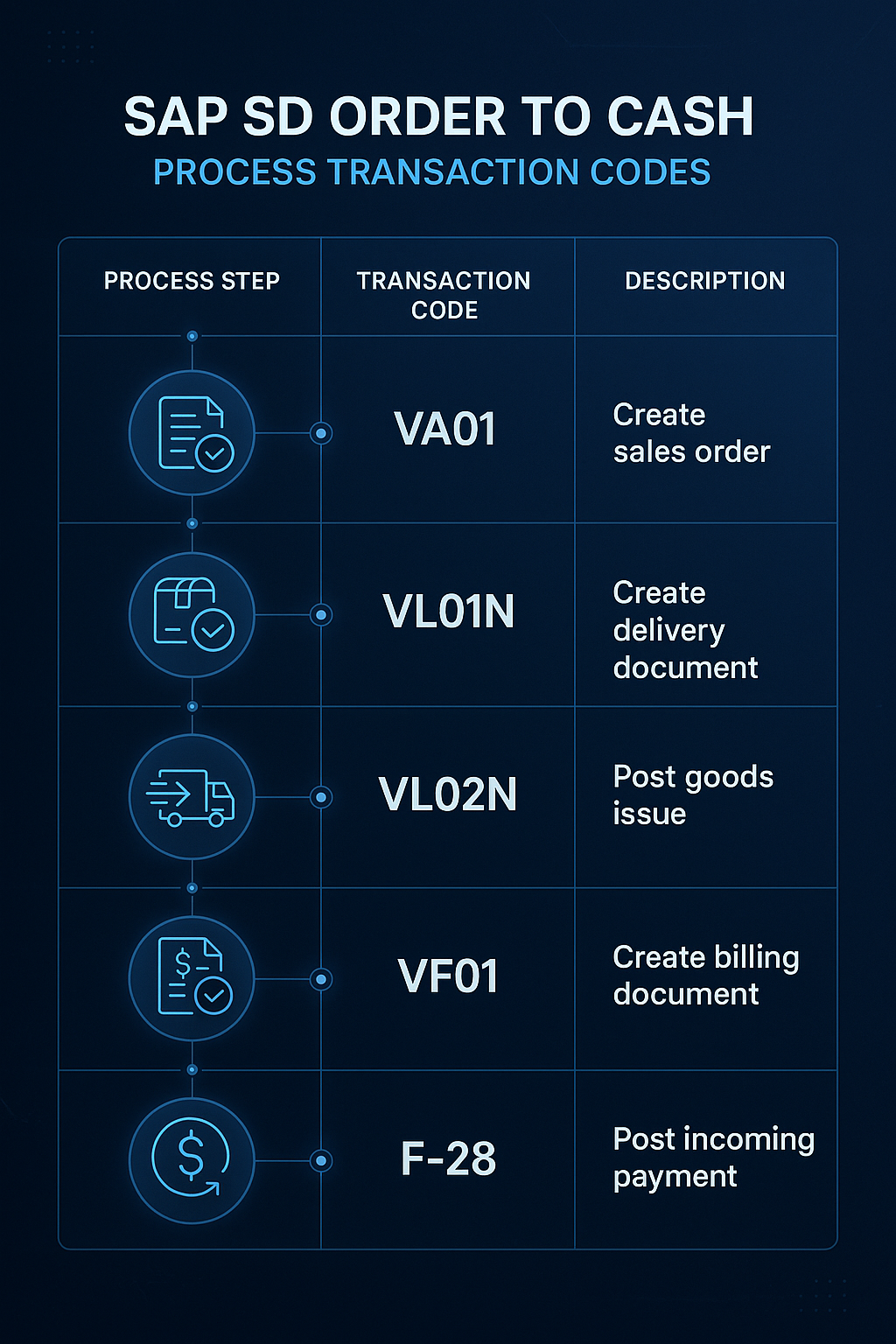
| Process Step | Transaction Code | Description |
|---|---|---|
| Create Sales Order | VA01 | Initializes the sales process by creating a formal sales order va. |
| Create Delivery Document | VL01N | Generates the document needed for warehouse picking and packing. |
| Post Goods Issue | VL02N | Updates inventory, records the cost of goods sold, and confirms shipment. |
| Create Billing Document | VF01 | Generates the customer invoice for payment. |
| Post Incoming Payment | F-28 | Clears the customer's accounts receivable balance once payment received. |
Benefits of SAP SD Order to Cash
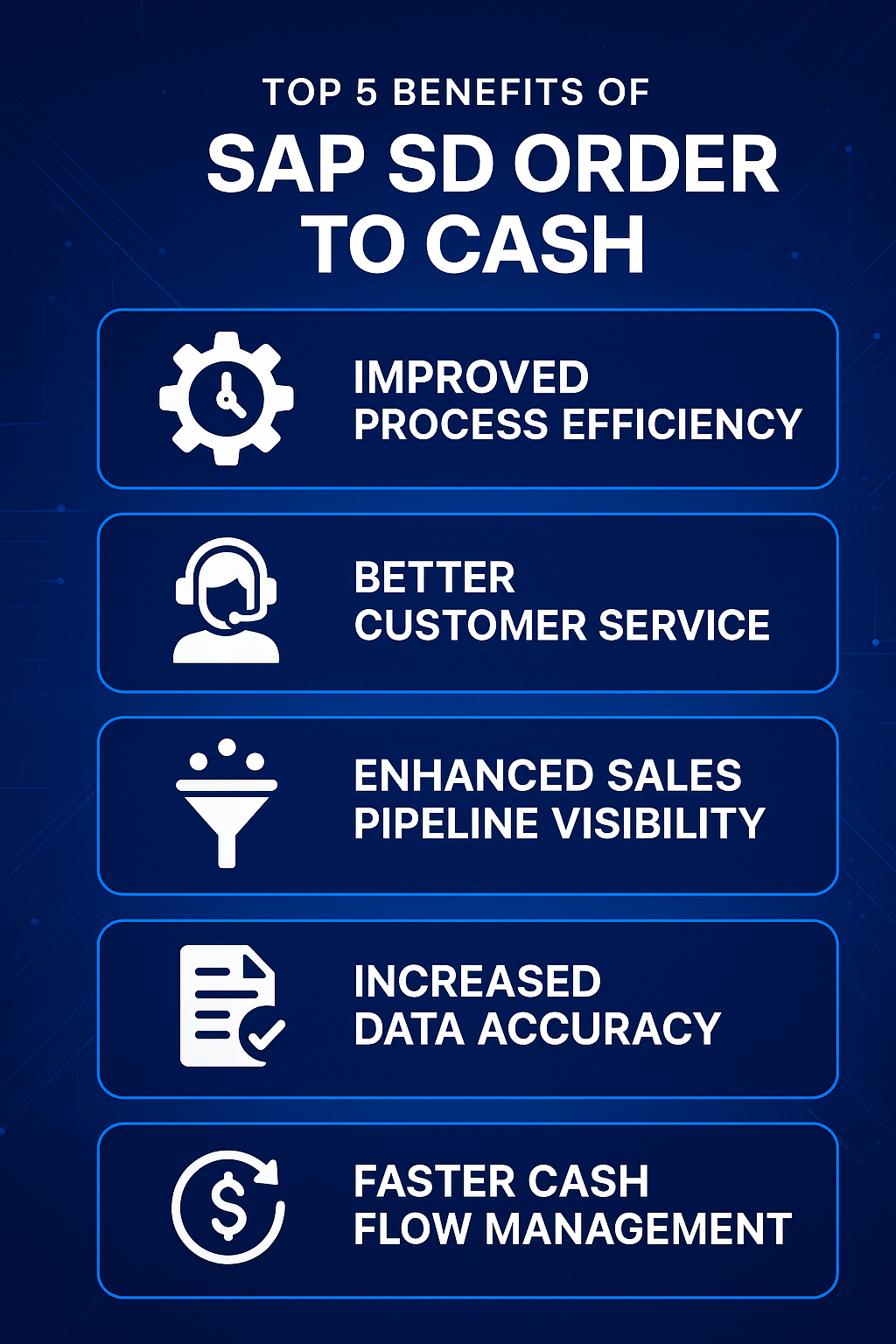
Now that we have covered the basics of how the process works, let's examine why businesses benefit from this integrated system. The advantages go beyond simple order taking and impact the entire organization. The ability to manage sales effectively is a cornerstone of success.
Improved Efficiency
The SAP SD module automates manual tasks throughout the sales cycle, significantly reducing the amount of manual work required. This automation minimizes the chance of human error, accelerates processing times, and leads to more satisfied customers. The efficiency gained allows employees to focus on more strategic activities rather than routine data entry.
Better Customer Service
With all customer and order information centralized, your sales team can provide faster and more accurate service. They can instantly check stock availability, confirm delivery dates, and resolve billing questions in real time. This responsiveness builds trust and improves the overall customer experience.
Enhanced Visibility
The SAP SD module provides a transparent view of the entire sales pipeline. Managers can easily track sales orders, monitor key performance indicators, and identify potential bottlenecks before they become major problems. This visibility allows for proactive decision-making and better control over the sales operation.
Increased Accuracy
By minimizing manual data entry, the system greatly improves the accuracy of sales orders, deliveries, and billing documents. This leads to fewer invoice disputes, quicker payments, and stronger customer relationships. Accurate data also provides a reliable foundation for financial reporting and business analytics.
Better Cash Flow Management
Automated billing and streamlined payment processing help businesses manage their cash flow more effectively. The system provides clear insights into accounts receivable, making it easier to follow up on overdue payments. A shorter order-to-cash cycle means the company receives payment faster, improving its liquidity position.
Implementing SAP SD Order to Cash
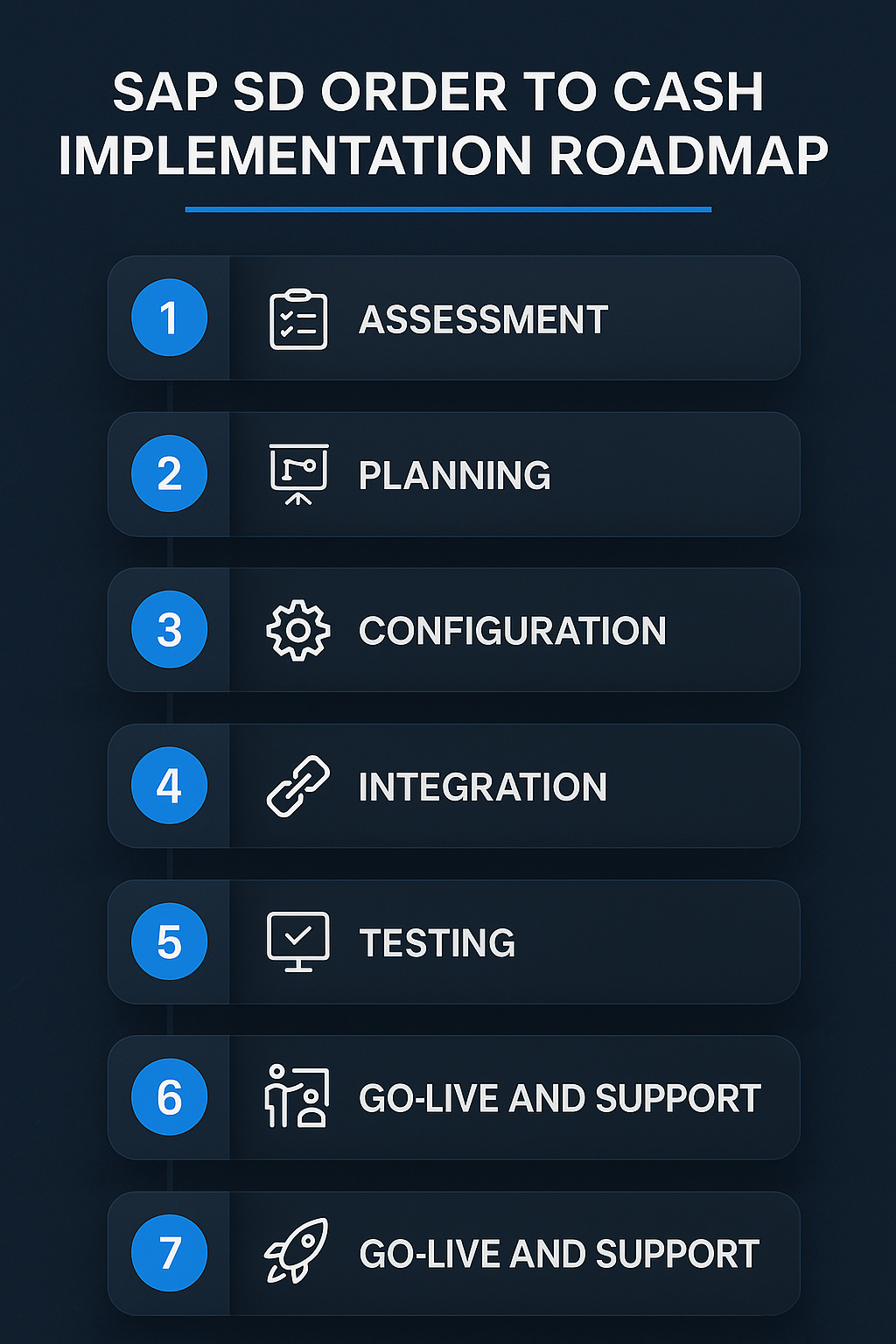
Getting started with the SAP OTC process requires careful planning and execution. A successful implementation can transform your sales operations. Here are some of the fundamental steps involved in the project.
1. Assessment
The first step is to evaluate your existing sales processes. Identify current pain points, inefficiencies, and areas that could be improved. This analysis helps you define the project scope and set clear objectives for the SAP implementation.
2. Planning
Develop a comprehensive implementation plan that includes realistic timelines, resource assignments, and a change management strategy. Proper planning is essential for keeping the project on track and within budget. This roadmap will guide the entire implementation team.
3. Configuration
This stage involves setting up the SAP SD module to align with your company's business processes. This includes defining your organizational structure, creating the necessary master data, and configuring rules for pricing and credit management. This configuration ensures the system supports your specific operational needs.
4. Integration
Confirm that the SAP SD module is correctly integrated with other relevant systems, both within and outside of SAP. Proper integration is critical for realizing the full benefits of a streamlined order-to-cash process. Data must flow smoothly between sales, finance, and logistics.
5. Testing
Before going live, the system must be tested thoroughly. This involves multiple rounds of testing, including unit tests for individual components and integration tests for the end-to-end process. User acceptance testing confirms that the system meets business requirements from the end-user's perspective.
6. Training
Provide detailed training for all users who will interact with the new system. Effective training is essential for ensuring a smooth transition and encouraging user adoption. Well-trained employees are more likely to leverage the system's full potential.
7. Go-Live and Support
Plan for a controlled go-live and have a dedicated support team in place to address any issues that arise. Providing strong post-launch support helps resolve problems quickly and builds user confidence in the new system. Continuous improvement is part of the long-term journey.
Real-World Success Stories
Let's look at some examples of companies that have seen tangible results from implementing the SAP Order to Cash process.
Global Electronics Manufacturer
A prominent electronics company implemented the SAP OTC process and achieved a 30% reduction in order processing time. They also improved their on-time delivery rate from 85% to 98%. This showcases the power of efficient order management and warehouse management integration.
Multinational Beverage Company
This business lowered its Days Sales Outstanding (DSO) by 15 days after adopting the SAP process. Additionally, they experienced a 25% drop in billing errors. These improvements directly translated to better cash flow and higher customer satisfaction.
Automotive Parts Supplier
By implementing SAP SD, this company pushed its order accuracy to an impressive 99.9%. They also cut their entire order-to-cash cycle time by 40%. This level of efficiency provided a significant competitive advantage in a demanding market.
Common Challenges and How to Overcome Them
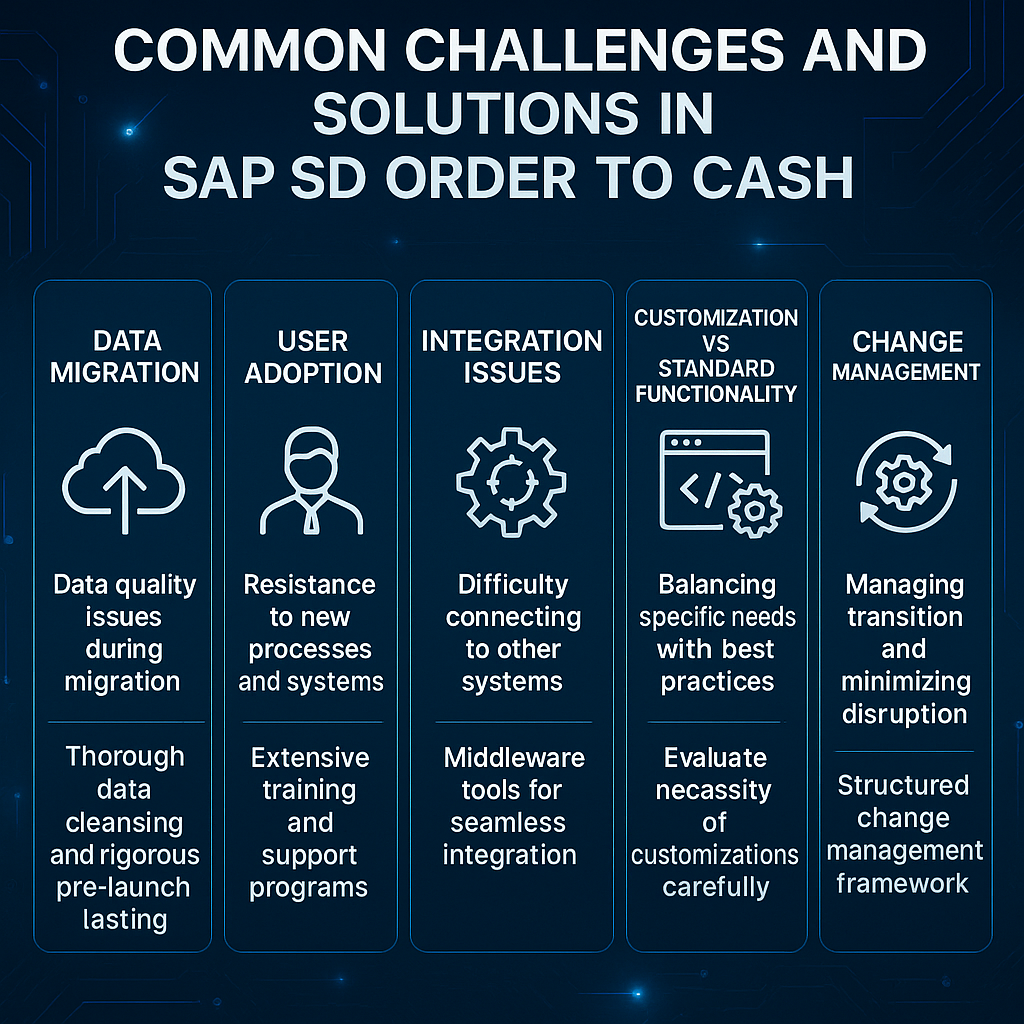
While the SAP Order to Cash process offers significant advantages, implementation can present challenges. Being aware of these potential hurdles is the first step to overcoming them.
Data Migration
Transferring data from old systems can be a complex task. The solution involves careful planning, extensive data cleansing to ensure quality, and rigorous testing before the final migration. Accurate master data is the foundation of a successful system.
User Adoption
Employees may sometimes be resistant to changing their established workflows. This can be addressed through comprehensive training, clear communication about the system's benefits, and continuous support from management. Appointing key users as champions can also help drive adoption.
Integration Issues
Achieving seamless integration with other modules and third-party applications can be technically challenging. Success depends on careful planning, using proven integration methodologies, and thorough testing of all data flows. A dedicated integration team is often necessary for complex landscapes.
Customization vs. Standard Functionality
While it can be tempting to heavily customize the system, this often leads to higher maintenance costs and future upgrade challenges. It is best to stick with standard SAP functionality whenever possible. Customizations should only be considered when a critical business requirement cannot be met otherwise, with a clear legal disclosure of the changes.
Future Trends in SAP SD Order to Cash
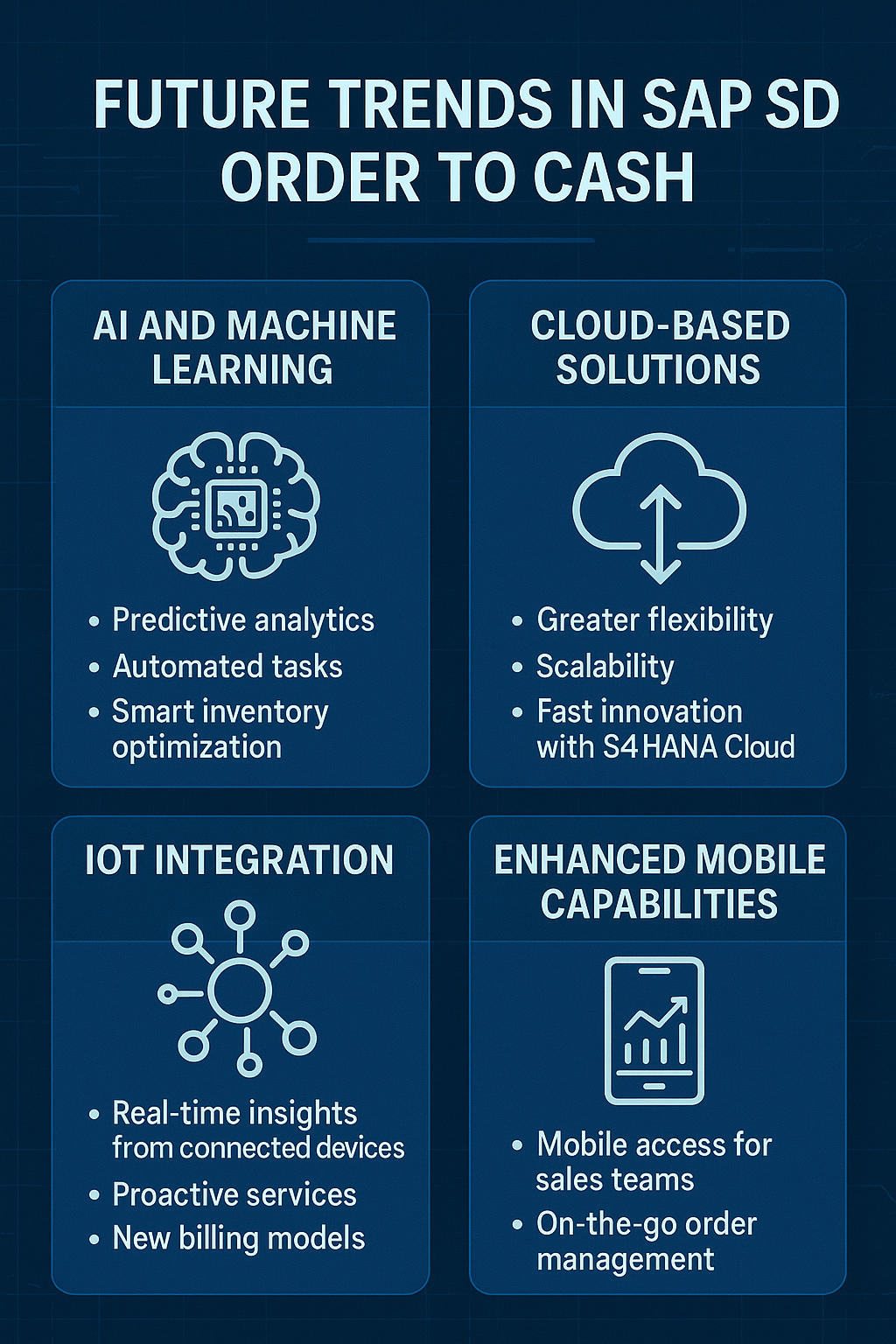
As business and technology change, the SAP OTC process continues to advance. Here are some key trends shaping its future.
AI and Machine Learning
These technologies are being integrated into the SAP S/4HANA suite to offer predictive analytics, automate routine tasks like sales order creation, and improve decision-making. AI can help with demand forecasting and optimizing inventory levels.
Pro-Tip 1: Leverage AI for Exception Management: Automate exception handling by incorporating SAP S/4HANA’s embedded AI algorithms to flag and resolve anomalies in order processing. This proactive approach minimizes manual intervention and shortens cycle times.
Cloud-Based Solutions
SAP is increasingly focusing on cloud-based solutions like SAP S/4HANA Cloud. This approach offers businesses greater flexibility, scalability, and reduced infrastructure overhead. Cloud deployments also allow for faster innovation cycles.
Pro-Tip 2: Prioritize Seamless Cloud Integration: When migrating to SAP S/4HANA Cloud, conduct a comprehensive integration analysis with legacy systems and external applications. Early identification of interface requirements ensures uninterrupted data flow and maximizes ROI from your cloud investment.
Internet of Things (IoT) Integration
Integrating IoT devices provides real-time data on product usage and equipment performance. This information can be used to enable proactive maintenance services and create new, usage-based billing models. It connects the physical world with the digital sales process.
Pro-Tip 3: Exploit Real-Time IoT Insights: Use IoT-enabled tracking to monitor product performance and inventory in real time. Setting up usage-based alerts allows for predictive maintenance, reduction of stockouts, and improved customer satisfaction.
Enhanced Mobile Capabilities
Modern mobile applications are making it easier for sales teams to manage customer orders and access critical information from anywhere. Mobile access improves productivity and responsiveness, allowing sales representatives to process customer requests while on the go.
Conclusion
The SAP SD Order to Cash process is a comprehensive solution that can fundamentally improve your business operations. By streamlining the entire sales cycle, from order creation to when the company receives payment, it enhances accuracy and provides crucial business insights. This helps you remain competitive in a dynamic business landscape.
Whether your business is a small enterprise looking to grow or a large corporation focused on optimization, the SAP OTC process offers tangible benefits. It is about more than just processing sales orders; it is about building a more efficient, customer-centric, and profitable organization. The interconnected steps work together to create a powerful engine for revenue generation.
Are you ready to elevate your sales process with SAP SD Order to Cash? The framework for seamless and efficient sales management is available today. Adopting it can be a defining step for your business's future success.
Need Expert SAP Consulting Expertise?
We are team of top-level SAP consultants, focused on helping you get the most value from your SAP investment. Whether you need a single SAP SD consultant or an entire team of SAP experts, we can provide them. Please our book a meeting service to get started.




